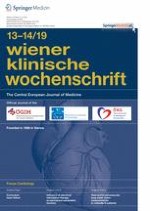08.05.2019 | original article
Real-world extravascular lung water index measurements in critically ill patients
Pulse index continuous cardiac output measurements: time course analysis and association with clinical characteristics
Erschienen in: Wiener klinische Wochenschrift | Ausgabe 13-14/2019
Einloggen, um Zugang zu erhaltenSummary
Background
Pulse index continuous cardiac output (PiCCO) is used for hemodynamic assessment. This study describes real world extravascular lung water index (EVLWI) measurements at three time points and relates them to other hemodynamic parameters and mortality in critically ill patients admitted to a medical intensive care unit (ICU).
Methods
A total of 198 patients admitted to a tertiary medical university hospital between February 2004 and December 2010 were included in this retrospective analysis. Patients were admitted for various diseases such as sepsis (n = 22), myocardial infarction (n = 53), pulmonary embolism (n = 3), cardiopulmonary resuscitation (n = 15), acute heart failure (AHF; n = 21) and pneumonia (n = 25).
Results
Patients included in this analysis were severely ill as represented by the high simplified acute physiology score 2 (SAPS2, 42 ± 18) and acute physiology and chronic health evaluation score 2 (APACHE2‚ 22 ± 9). Real-world values at three time points are provided. Intra-ICU mortality rates did not differ between the EVLWI > 7 vs. the ELVWI < 7 groups (15% vs. 13%; p = 0.82) and no association between hemodynamic measurements obtained by PiCCO with long-term mortality could be shown.
Conclusion
There were no associations of any PiCCO measurements with mortality most probably due to selection bias towards severely ill patients. Future prospective studies with predefined inclusion criteria and treatment algorithms are necessary to evaluate the value of PiCCO for prediction of mortality against simple clinical tools such as jugular venous pressure, edema and auscultation.
Anzeige
